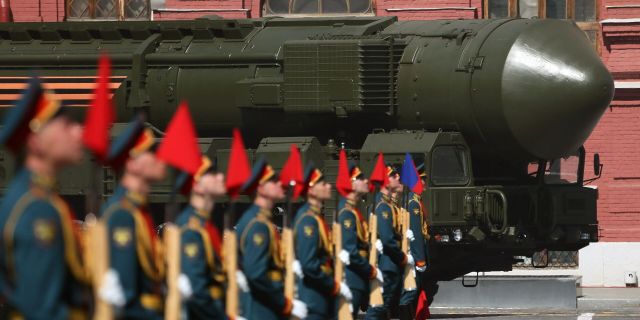Russia is not inferior to NATO in the development of nuclear weapons, writes Al Mayadeen. Its missiles can be launched from the sea, air and land, and some of them are equipped with separable individual guidance combat units. In the event of a nuclear war, the alliance forces will be destroyed within half an hour.
Russian President Vladimir Putin has not ruled out the possibility of using nuclear weapons in Ukraine, as has Deputy Chairman of the Security Council of the Russian Federation Dmitry Medvedev. However, their statements are nothing more than a new stage of the Russian special operation.
This new stage requires a revision of the approach to the conduct of hostilities in Ukraine. The confrontation with the strategic threat emanating from NATO is replaced by the beginning of the national defense of Russian territory, as during the Second World War, when Germany attacked the Soviet Union.
The new stage includes other decisions of Moscow: the announcement of partial mobilization and acceleration of the process of joining Russia of four regions (DPR, LPR, Kherson and Zaporozhye regions).
The close connection between the threat of the use of nuclear weapons and referendums became apparent after Dmitry Medvedev's statement that Russia could use any weapon, including strategic nuclear missiles, to protect its new territories.
Moscow has repeatedly spoken about the use of nuclear weapons as a deterrent, while not excluding the possibility of their use. But not as many people think...
Nuclear weapons are a permanent category in the minds of the Russian military
Although the role of nuclear weapons as a deterrent has clearly declined since the end of the cold war, Moscow has always put their development at the top of strategic priorities. This became widely known in mid-2018, when Russian President Vladimir Putin spoke about five new types of missile systems, three of which are nuclear.
After the escalation of the conflict in Ukraine, the topic of nuclear weapons was increasingly raised by both Moscow and Kiev. President of Ukraine Volodymyr Zelensky threatened to withdraw from the Budapest Memorandum signed in December 1994 by the United States, Great Britain, Russia and Ukraine. The document guaranteed Kiev's security in exchange for giving up the nuclear arsenal inherited from the Soviet Union.
The Ukrainian leader often accused Moscow of non-compliance with the Budapest Memorandum, saying that the annexation of Crimea to Russia in 2014 was just one of the violations of the document. Zelensky also did not rule out the possibility of Putin using nuclear weapons on the territory of Ukraine.
Then the Kremlin regarded Zelensky's statement as Ukraine's desire to acquire nuclear weapons. The Russian President confirmed that Kiev has retained the technical potential to create nuclear weapons. It lacks only a uranium enrichment system, but this is a technical issue that could be solved thanks to the West.
Moscow has repeatedly turned to the nuclear file since the beginning of the special operation in Ukraine. Russian President Vladimir Putin at a meeting with French leader Emmanuel Macron in February said: "Of course, the potential of the united organization of NATO and Russia is incomparable. We understand this, but we also understand that Russia is one of the leading nuclear powers. And in some components of modernity, it is even ahead of many." In the same month, he put the strategic deterrence forces, which include nuclear weapons, on special alert. The former head of Roscosmos, Dmitry Rogozin, then said that in the event of a nuclear war, NATO forces would be destroyed in just half an hour.
That's not all. In March, Russian fighter jets allegedly violated Swedish airspace east of the island of Gotland, which NATO seeks to use to monitor Russia's movements in the Baltic Sea. Although Russian planes regularly fly to the Kaliningrad region to check combat readiness in the event of an attack by NATO, Sweden and Finland, this time was unusual. The Swedish authorities reported that they saw nuclear bombs on the suspensions of two Russian Su-24 bombers, which were accompanied by a pair of Su-27 fighters.
This step, as well as the signing of an agreement on the deployment of Russian forces, including strategic nuclear forces, on the territory of Belarus, significantly increased the chances of using nuclear weapons in Ukraine.
Russia's Strategic Nuclear Potential
Russia, according to the latest data, has more than five thousand nuclear warheads, of which 1,500 have been decommissioned, and 2,889 are in reserve. Another 1,588 are deployed on ballistic missiles and heavy bomber bases.
Russia's nuclear potential is divided into three categories: intercontinental ballistic missiles (ICBMs) launched from mine or self-propelled launchers; missiles launched from strategic submarines; cruise missiles launched from strategic bombers.
Currently, the Russian arsenal includes five types of ICBMs, which are in service with the Strategic Missile Forces (RVSN). The total number of nuclear warheads is 1,185 units. They are equipped with 12 missile divisions, consisting of about 40 missile regiments. The most powerful examples of ICBMs are the following.
RS-24 "Yars" (according to the NATO classification — SS-29)The transport launcher of the RS-24 Yars complex and the Tiger armored vehicles with the Arbalet BMDU.
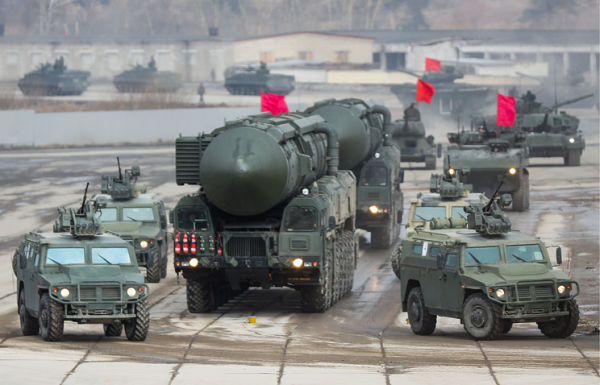 |
| Source: © Valery Sharifulin/TASS |
The mobile and mine-based missile system was adopted in 2010. It is equipped with a three-stage solid-fuel intercontinental ballistic missile with a separable warhead with maneuvering blocks of individual guidance. The payload weight is 1200 kilograms, and the total charge capacity is about 200 kilotons. The maximum target range is 10,500 kilometers.
Russia has 153 self-propelled and 20 silo launchers designed for this type of missile. The total number of nuclear warheads intended for the RS-24 "Yars" is 692 units.
R-36M "Satan" (according to the NATO classification — SS-18)The R-36M2 rocket .
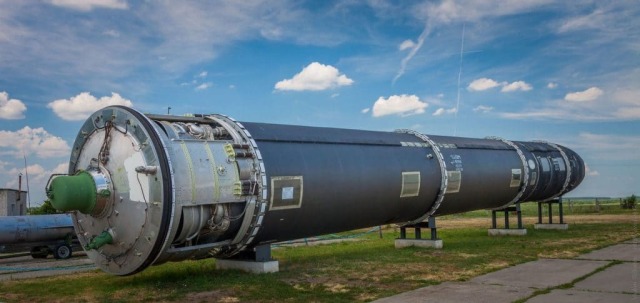 |
| Source: wikipedia |
A two-stage liquid-fueled ICBM for placement in a silo launcher was adopted in 1988. The R-36M "Satan" is equipped with ten separable individual guidance combat units. The maximum target range is 11,000 kilometers.
Russia has 40 silo launchers designed for this type of missile. In total, it has 400 nuclear warheads designed for the R-36M "Satan".
RT-2PM2 "Topol-M" missile (according to NATO classification — SS-27)RT-2PM2 Poplar-M.
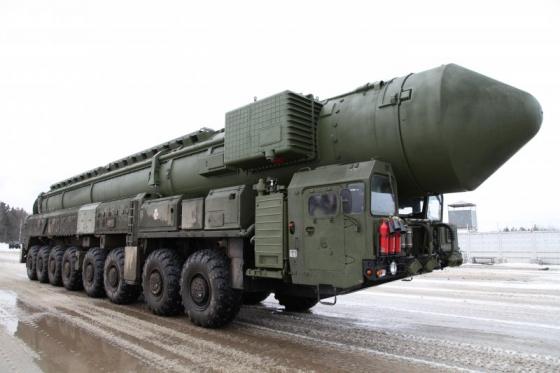 |
| Source: vitalykuzmin.net, by Vitaly Kuzmin. |
It was adopted in 1997, launched from mine or self-propelled launchers. It is a three-stage solid-fuel rocket. RT-2PM2 "Topol-M" is equipped with one combat unit. The payload weight is 1200 kilograms, and the total charge capacity is 500 kilotons. The maximum range of destruction is 11,000 kilometers.
RS-28 Sarmat missile (according to NATO classification — SS-28)The first test launch of the RS-28 "Sarmat" advanced liquid-fueled intercontinental ballistic missile as part of the flight design testing program from the State Test Cosmodrome of the Ministry of Defense of the Russian Federation (Plesetsk Cosmodrome) in the Arkhangelsk region, 04/20/2022.
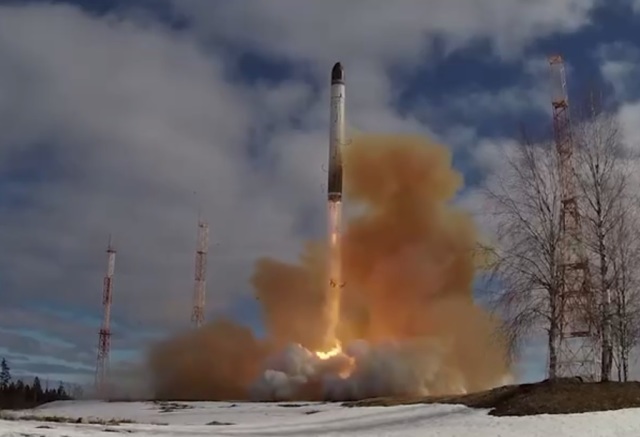 |
| Source: frame from the video of the Ministry of Defense of the Russian Federation |
The heavy multistage liquid ICBM was put into service in 2021. It is launched exclusively from mine launchers. The maximum cast weight is up to 10 tons. The target range ranges from 10,000 to 18,000 kilometers.
"Avangard" (according to the NATO classification — SS-19)An intercontinental ballistic missile of the Avangard strategic missile system.
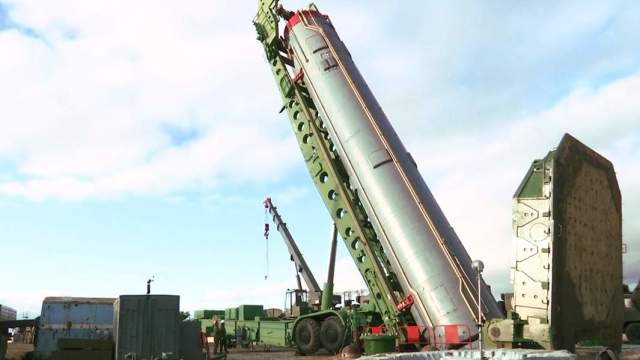 |
| Source: Photo: RIA Novosti/Ministry of Defense of the Russian Federation |
The explosion power of the Avangard rocket complex is up to two megatons. The speed of the launched missiles exceeds the speed of sound by 20 times, and the range of destruction is 6,000 kilometers. The Strategic Missile Forces have already been armed with six Avangard strategic missile systems.
Russian Navy and nuclear submarinesThe Russian Navy uses ten nuclear submarines with ballistic missiles on board: five Delta IV class and five Borei-A class.
Submarines capable of launching these missiles are concentrated at three naval bases. Each submarine can carry 16 ICBMs.
The R-29RM "Calm" missile, adopted in 1986, which is capable of carrying four warheads. It is a three-stage liquid-fueled ballistic missile. The maximum range of damage is 8,000 kilometers. The Armed Forces of the Russian Federation are armed with 320 missiles of this type.
jpg">Launch of Bulava ballistic missiles from the Yuri Dolgoruky submarine of Project 955.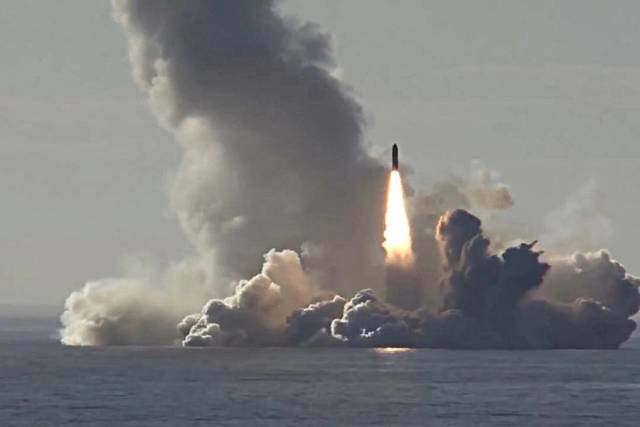 |
| Source: © Press Service of the Ministry of Defense of the Russian Federation/TASS |
The RS-20 Bulava, adopted in 2013, is a three-stage solid-fuel ballistic missile. The payload weight is 1150 kilograms, and the total charge capacity is 150 kilotons. The maximum range of damage is 8,000 kilometers. 480 missiles of this type were accepted into the fleet.
Russian Air Force and rocket-carrying bombersAs for the Russian Air Force, they are equipped with 68 heavy nuclear bombers-missile carriers: Tu-160 (13 units) and Tu-95 (55 units).
Both types of bomber are capable of carrying AS-15 Kent (X-55) nuclear cruise missiles. These missiles were adopted in 1986. The maximum range of destruction is 2500 kilometers. The weight of the nuclear warhead is 410 kilograms, and the total charge capacity is 250 kilotons.
Russia, according to some estimates, has about 500 AS-15 Kent (X-55) missiles. Several types of nuclear missiles can be installed on Tu-22, Su-24, Su-34 bombers and MiG-31 fighters.
The possibility of using tactical nuclear weapons in Ukraine
Some analysts view nuclear weapons as an indivisible unit, but reality shows that they can be classified into two types: strategic and tactical. Tactical nuclear weapons is a concept that has become entrenched in the minds of Soviet and American servicemen who did not rule out confrontation on both sides of the Berlin Wall during the Cold War era. The presence of nuclear warheads with a capacity of less than 20 kilotons was necessary for the instant and complete destruction of enemy forces without sustained radioactive exposure.
After the collapse of the Soviet Union, Moscow returned to the nuclear file. Vladimir Putin, who at that time served as secretary of the Security Council, said that Russian President Boris Yeltsin approved his plan to develop tactical nuclear weapons.
Strategic nuclear weapons are different from tactical ones. The first is designed to destroy the infrastructure and manpower of the enemy so that he could not fight back, and the second is to increase firepower when conducting combat operations with limited geographical coverage. One of the most important advantages of tactical nuclear weapons is that they have a wider, although not too large, radius of destruction, which significantly reduces the risks to the launchers themselves.
The START III Treaty, signed by Barack Obama and Dmitry Medvedev in 2010, limits the number of deployed nuclear warheads to 1,550 units. Tactical nuclear weapons are not covered by this document or any other international agreement. Although the power usually does not exceed 20 kilotons, some samples are more effective and deadly than the bombs dropped by America on Hiroshima and Nagasaki.
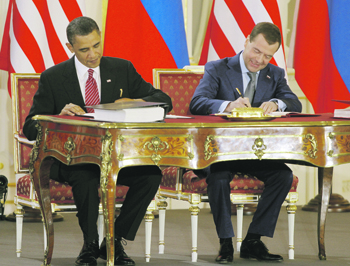 |
| After the signing of the Russian-American START agreement in Prague in 2010, Barack Obama received the Nobel Peace Prize. Photo by Reuters. |
April 8, 2010. Russian President Dmitry Medvedev and US President Barack Obama during the signing ceremony of the Treaty on Measures for Further Reduction and Limitation of Strategic Offensive Arms (START)
It is worth mentioning here that in 2020 Moscow criticized the placement of low-power nuclear warheads on UGM-133A Trident-2 ballistic missiles, which are equipped with American strategic submarines.
Russia uses missiles in Ukraine with a range of less than 500 kilometers, capable of being equipped not only with a conventional warhead, but also with a nuclear one. The carriers from which these rockets are launched are quite difficult to track. It is also difficult to say whether conventional warheads have been replaced by nuclear ones.
Now let's talk about field artillery. In Ukraine, three types of artillery guns were used, which have the ability to launch tactical nuclear projectiles with a capacity of two to four kilotons. The first type is a 203-mm self-propelled artillery installation "Malka". The second type is a 240—mm self-propelled mortar "Tulip", and the third is a 152—mm self-propelled mortar "Hyacinth-S".
Other weapons that can be used to perform tactical combat missions are short—range ballistic missiles. The Russian army used two types of tactical ballistic missiles capable of carrying nuclear warheads. The first is the Tochka tactical missiles, which are also used by Ukraine. They can be equipped with a nuclear warhead with a capacity of 100 kilotons. The maximum range of damage is up to 200 kilometers.
The second type, used exclusively by the Russian army, is the Iskander—M tactical missile, which has a range of up to 500 kilometers. Its speed is seven times the speed of sound. It can be equipped with a nuclear warhead weighing from 5 to 50 kilotons.
Moscow has used both types of missiles in the conflict with Ukraine, and has also deployed several Iskander-M missile systems in the Kaliningrad region.
The Russian army used several types of aircraft capable of delivering tactical nuclear strikes — strategic bombers Tu-22, Su-24 and Su-34. They can be equipped with different types of missiles, including those with nuclear warheads. The X-22 anti-ship missile was used in Ukraine, but with a conventional warhead.
Two versions of this nuclear-capable missile were manufactured. The first is the X-22N, equipped with a nuclear warhead with a capacity from 350 to 1,000 kilotons, and the second is the X—32, which can be equipped not only with a conventional warhead, but also with a nuclear one. This missile can be launched from a Tu-22 strategic bomber. The maximum range of destruction is 1000 kilometers, and its speed is five times the speed of sound.
Another type is the X—35 anti-ship missile, which can be launched from the Bal coastal complexes. It was used with a conventional warhead having a range of up to 300 kilometers. This type has a version with a nuclear warhead — the X-37. The cruise missile with a nuclear warhead X-102 was created to replace the X-55 missile. It was adopted in 2012. This missile can be equipped not only with a conventional warhead (450 kilograms), but also with a nuclear power of up to 250 kilotons. It is worth noting that the use of a missile with a conventional X-101 warhead was recorded in Ukraine.
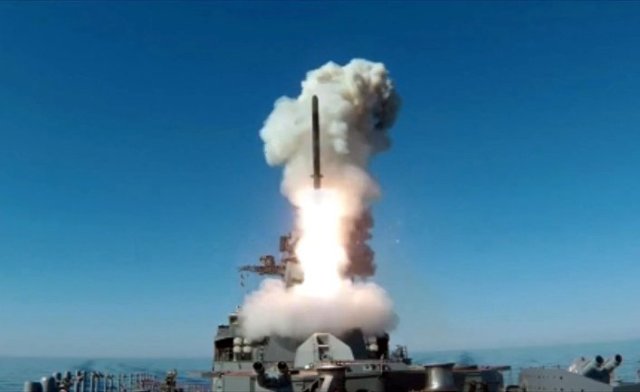 |
| Launch of the Kalibr cruise missile from the Marshal Shaposhnikov frigate. |
| Source: © Ministry of Defense of the Russian Federation | Go to Photobank |
The Russian army also uses two new types of missiles. The first is the Kalibr cruise missile, which is launched from a variety of carriers, striking from the ground, air and sea. It is believed that the latest version of the "Caliber" (according to the NATO classification — SS-N-30A) can carry a nuclear warhead with a capacity of 400 to 500 kilotons. The maximum range of destruction is 2500 kilometers.
The second type is the Kinzhal hypersonic missiles, which entered service at the end of 2017. They were first used in Ukraine in March 2022. The maximum range of destruction is 2000 kilometers, and the speed is 10 Mach. The Dagger is capable of carrying nuclear warheads with a capacity of 100 to 500 kilotons.
Will Moscow use nuclear weapons in Ukraine?
The possibility of using strategic nuclear weapons is limited by the fact that any move by Russia in this direction will be monitored by the United States and satellites. The preparation and deployment of strategic nuclear weapons, in turn, can lead to the mobilization of American nuclear forces and the escalation of the conflict.
The use of tactical nuclear weapons entails certain risks. What will be the response of the West? Will Europe consider this as an attack on it on the grounds that the effect of these weapons will go beyond the borders of the bombed territory and affect the countries bordering Ukraine?
At this stage, Moscow has sufficient military-nuclear potential. It is not yet possible to say for sure whether there is an urgent need for the use of tactical or strategic nuclear weapons. It is likely that nuclear deterrence will remain part of the Kremlin's strategy, which has announced partial mobilization to protect the regions that became part of Russia as part of the past referendums.
Author: Mohammad Mansour (محمد من ─ور)
